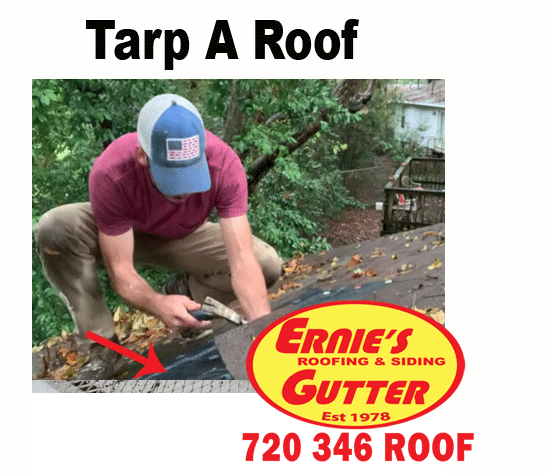How To: Tarp a Roof in Denver
How To: Tarp a Roof in Denver
When your roof suffers damage—whether from a storm or another unexpected event—taking immediate action is crucial. In Denver, where the weather can be unpredictable, knowing how to tarp a roof is an essential skill. This temporary fix can help you prevent further damage until professional repairs can be made. As a third-generation roofing contractor from Ernie’s Roofing, a trusted Denver institution since 1978, I’m here to walk you through the process step-by-step. Whether you’re dealing with roof damage, storm damage, or need help with an insurance claim, this guide is designed to provide you with the knowledge to protect your home effectively.
Understanding Roof Damage: The Basics
Roof damage can occur in various forms, from minor issues like a few missing shingles to severe problems like structural damage caused by high winds or falling debris. In Denver, we often see roof damage caused by:
- Hailstorms: Hail can cause significant damage, including dents, cracks, and punctures in roofing materials.
- High Winds: Winds can lift and tear off shingles, leaving your roof vulnerable to leaks.
- Heavy Snow and Ice: The weight of snow and the formation of ice dams can cause structural damage and leaks.
- Falling Debris: Trees or other objects falling onto your roof during a storm can cause immediate and severe damage.
When you notice any signs of roof damage, it’s essential to act quickly. Water infiltration can lead to mold growth, structural issues, and further deterioration of your home. Tarping your roof is a temporary but effective way to protect your property while you arrange for professional repairs.
Step-by-Step Guide: How to Tarp a Roof
1. Assess the Damage
Before you begin, carefully inspect the damaged area. Determine the extent of the damage and identify the exact location of the affected shingles. In many cases, the damage may be localized to a small area, making it possible to cover it with a smaller tarp.
2. Choose the Right Tarp
A common mistake is using a tarp that’s too large, which can lead to unnecessary complications. For most minor damage, a 6×8 tarp is sufficient. If the damage is more extensive, you may need a larger tarp, but always try to minimize the area you cover to prevent over-tarping.
3. Gather Your Tools
You’ll need a few basic tools:
- A trowel, putty knife, or small crowbar
- Cap nails (available at hardware stores like Home Depot or Lowe’s)
- A hammer
- Scissors or a utility knife to trim excess tarp material
4. Lift the Shingles
Using your trowel or putty knife, gently lift the shingles around the damaged area. Be careful not to cause further damage. You want to create just enough space to slide the tarp underneath the shingles.
5. Position the Tarp
Slide the tarp under the lifted shingles, ensuring it covers the damaged area completely. The tarp should be positioned so that water will run off without getting underneath it. This is crucial for preventing leaks.
6. Secure the Tarp
Begin nailing the tarp in place using cap nails. Place the nails in a diagonal or horizontal pattern to keep the number of holes to a minimum. This reduces the risk of water infiltration through the nail holes. If you’re in an area with high winds, you may need to use 2x4s or 1x6s to hold the tarp down more securely.
7. Trim Excess Material
Once the tarp is secured, trim any excess material. This not only improves the appearance but also reduces the risk of someone tripping over loose tarp edges.
8. Monitor the Situation
Remember, tarping is a temporary solution. It’s essential to monitor the tarp regularly and arrange for permanent repairs as soon as possible. Don’t wait for the tarp to fail before taking action.
Tips for Best Roof Repair Practices in Denver
As a seasoned roofing contractor, I’ve seen the best and worst of roof repairs. Here are some tips to ensure that your roof repair goes smoothly and effectively:
1. Hire a Licensed Contractor
Always work with a licensed roofing contractor who has experience with the specific challenges of Denver’s climate. At Ernie’s Roofing, we bring decades of experience to every job, ensuring high-quality results.
2. Get a Thorough Inspection
After any storm or significant weather event, have your roof inspected by a professional. Even if you don’t see visible damage, there could be underlying issues that need attention.
3. Document Everything
If you’re filing an insurance claim, document the damage thoroughly. Take photos, keep records of any repairs, and work closely with your insurance company to ensure you receive the coverage you’re entitled to.
4. Choose Quality Materials
When repairing or replacing your roof, invest in high-quality materials. In Denver, impact-resistant shingles can be a smart choice, as they offer better protection against hail and wind.
5. Plan for Regular Maintenance
Regular roof maintenance can extend the life of your roof and help prevent future damage. Schedule annual inspections and address any minor issues before they become major problems.
6. Be Aware of Common Scams
Unfortunately, storm damage can attract unscrupulous contractors. Always verify the credentials of any contractor you work with and be wary of those who pressure you into making quick decisions.
7. Consider a Roof Coating
For flat or low-slope roofs, a roof coating can provide an additional layer of protection against the elements. This can be especially useful in prolonging the life of your roof.
8. Understand Your Insurance Policy
Review your homeowner’s insurance policy to understand what is and isn’t covered. Some policies may have exclusions for certain types of damage, so it’s important to know what your responsibilities are.
9. Prepare for the Unexpected
Denver’s weather can be unpredictable, so it’s a good idea to have a plan in place for emergency roof repairs. Keep our number handy—720-346-ROOF—for fast, reliable service when you need it most.
10. Don’t Delay Repairs
Putting off roof repairs can lead to more significant damage and higher costs in the long run. Address issues as soon as they arise to protect your home and your investment.
Frequently Asked Questions (FAQ)
1. What should I do if my roof is damaged during a storm?
First, ensure your safety and the safety of your family. Once it’s safe, assess the damage and, if possible, tarp the roof to prevent further damage. Then, contact a licensed roofing contractor like Ernie’s Roofing to inspect and repair the roof.
2. How long can a tarp last on my roof?
A tarp is a temporary solution, typically lasting a few weeks to a few months, depending on the weather conditions. It’s important to arrange for permanent repairs as soon as possible.
3. Will my insurance cover the cost of tarping and roof repairs?
Most homeowner’s insurance policies will cover emergency repairs, including tarping, as part of a larger roof damage claim. Be sure to document everything and check with your insurance provider.
4. Can I tarp my roof myself, or should I hire a professional?
While you can tarp your roof yourself if you feel confident and have the right tools, hiring a professional is recommended, especially for larger or more complex damage.
5. How can I prevent future roof damage?
Regular maintenance, quality materials, and proper installation are key to preventing future roof damage. Additionally, trimming trees around your home can reduce the risk of falling debris.
6. What type of tarp should I use for roof damage?
A durable, waterproof tarp is best for roof damage. The size depends on the extent of the damage, but for minor repairs, a 6×8 tarp is usually sufficient.
7. How do I know if my roof needs to be replaced?
If your roof is more than 20 years old, has multiple leaks, or shows signs of significant damage (such as missing shingles or sagging), it may be time to consider a replacement.
8. What is the best time of year to repair or replace a roof in Denver?
Spring and early fall are ideal times for roof repairs or replacements in Denver, as the weather is typically mild. However, emergency repairs can be done year-round.
9. What are the signs of a roof leak?
Common signs of a roof leak include water stains on the ceiling, damp walls, peeling paint, and musty odors. If you notice any of these signs, contact a roofing professional immediately.
10. How can I find a reputable roofing contractor in Denver?
Look for a contractor with a long history in the community, positive customer reviews, and proper licensing and insurance. Ernie’s Roofing has been serving Denver since 1978 and is committed to providing top-quality service.
Conclusion
Tarping your roof is a vital step in protecting your home from further damage after a storm or other unforeseen event. While it’s a temporary solution, it buys you time to arrange for professional repairs. At Ernie’s Roofing, we’ve spent decades helping Denver homeowners navigate the challenges of roof damage, storm damage, and insurance claims. If you find yourself in need of emergency roof repair, don’t hesitate to contact us at 720-346-ROOF or visit our website at erniesroofing.com. With our experience and commitment to quality, you
OUR SERVICES
Your Neighborhood Roofing Contractor
Get more information concerning our service, do not wait to call us at 720 346 ROOF today. We’ll be more than happy to schedule a meeting with you.
Residential Roofing Contractor
Ernie’s Roofing specialize in residential roofing in Denver and have a team of experienced professional Roofers available to help you get the job done right The First Time. From minor repairs and maintenance to full–scale roof replacements,

Commercial Roofing
We construct, repair, as well as maintain Commercial Roofing systems for services both large and also small, creating personalized services that conserve our client’s time, cash, and also power. Call us at 720 346 ROOF and book a consultation today.

Hail Damage
Their knowledgeable staff is ready to help you assess the damage caused by storms and provide you with a comprehensive repair evaluation & plan. We specialize in all types of roof damage, including hail, wind, and even lightning strikes. Hail Claim Help

INSURANCE CLAIMS HELP
Our team of experienced insurance claim specialists will work with you to ensure that the insurance claim process is as stress-free as possible. We will work with your insurance company to provide all necessary documentation and estimates to ensure that your claim is processed quickly and correctly.

Wind Damage
When it comes to roof damage, it can be difficult to determine whether the damage was caused by hail or wind. While both types of damage can cause similar symptoms, they have different causes and require different repair methods.
What’s New on The Blog
Kind Of Roof
Welcome to Ernie’s Roofing, your go-to source for all things roofing. With our rich heritage as a third-generation family of contractors and a legacy dating back to 1978, we’ve seen it all when it comes to roofing in Denver. In this comprehensive guide, we’ll explore...
Roofing Shingles Denver
There’s a pair of things that are essential when selecting roof covering tiles as well as maintaining these concerns in mind can choose which roofing system tiles to choose much easier. Some top quality roof products, for instance solar roofing system tiles, can be a...
Do You Have Hail storm Damage?
As a licensed contractor from a third-generation family of contractors, Ernie’s Roofing has been proudly serving Denver since 1978. With our extensive experience and dedication to quality, we understand the unique challenges posed by Denver’s weather, particularly...
#1 Home Improvement Services
Craftsmanship That Stands Like a House
Let’s Get Your Project on the Right Track
Let’s Get Started
Ready to speak with an expert ?



